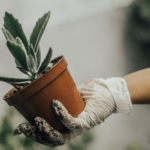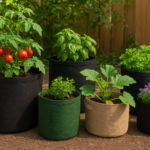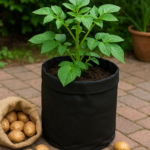The Coin Plant, also known as Pilea Peperomioides, is a beloved indoor plant that’s taken the world of home décor and houseplant enthusiasts by storm. With its round, coin-like leaves and easy-going nature, it’s a favorite for both beginners and seasoned plant lovers. Often dubbed the “Chinese Money Plant,” it’s not just a visual treat—it’s also believed to bring good fortune and positive vibes.
What really makes this plant stand out is its symmetrical foliage that radiates from a central stem, resembling a little green umbrella. Easy to care for and fast-growing, it checks all the boxes for a perfect houseplant. Plus, it fits seamlessly into modern, minimalist, and even boho interior styles.
From Instagram-worthy aesthetics to its low-maintenance nature, the Coin Plant is much more than just a pretty face. If you’re looking to add charm and life to your indoor space, this might just be the plant to get. Let’s explore everything you need to know to keep it thriving.
About Coin Plant (Pilea Peperomioides)

The Coin Plant (Pilea Peperomioides), also known as the Chinese Money Plant or Pancake Plant, is a trendy houseplant loved for its round, coin-like leaves and easy-going nature. Native to southern China, it became popular in the West after a Norwegian missionary shared cuttings in the 1940s. This compact, evergreen perennial thrives in bright, indirect light and well-draining soil, making it perfect for indoor gardening beginners. It symbolizes prosperity, luck, and friendship, often shared between friends as a thoughtful gift. With minimal care, the Coin Plant grows quickly and adds a touch of charm and greenery to any living space.
Origin and Botanical Background
| Aspect | Details |
|---|
| Scientific Name | Pilea Peperomioides |
| Common Names | Coin Plant, Chinese Money Plant, Pancake Plant, Missionary Plant |
| Family | Urticaceae |
| Plant Type | Evergreen Perennial |
| Native Region | Yunnan Province, Southern China |
| Discovery | First discovered in the wild by Western botanists in the early 20th century |
| Introduction to West | Brought to Europe in the 1940s by Norwegian missionary Agnar Espegren |
| Cultural Spread | Gained popularity through friend-to-friend sharing, not commercial trade |
| Symbolism | Wealth, prosperity, good luck, friendship |
| Global Recognition | Widely recognized and sold globally since early 2000s |
The Coin Plant hails from the mountainous Yunnan province of southern China. It was first brought to the West by a Norwegian missionary, Agnar Espegren, in the 1940s, which is why it’s also sometimes called the “Missionary Plant.” Despite its global fame today, it wasn’t widely available in stores until recent years—it was mostly shared among friends and families by propagation, earning its reputation as a “friendship plant.”
Scientifically, it belongs to the Urticaceae family. Its full botanical name is Pilea Peperomioides, and it’s a perennial evergreen. Its round, glossy leaves are supported by long, thin stems, giving it a unique architectural shape that’s both whimsical and elegant..
Symbolism and Cultural Significance
The Coin Plant isn’t just admired for its looks—it holds rich symbolic meaning. In Chinese culture, it’s associated with prosperity, wealth, and abundance. Its coin-shaped leaves are thought to attract money and financial fortune, which is why it’s often placed in homes and offices as a good luck charm.
In Feng Shui, it’s believed that placing a Coin Plant in the wealth corner (southeast) of your home can enhance monetary gain and stability. Many people also gift this plant during housewarming or business openings for symbolic blessings.
Its association with sharing and friendship also plays a huge role in its cultural value. Because it propagates easily and generously, it’s often passed from one person to another, symbolizing goodwill, growth, and continuity. In essence, it’s not just a plant—it’s a green emblem of positivity.
Ideal Growing Conditions

Getting the growing conditions right is crucial to enjoying a lush, vibrant Coin Plant. This plant loves bright, indirect sunlight. Think of placing it near an east-facing window or behind a sheer curtain in a sunny room. Avoid direct sunlight, especially in hot climates, as it can scorch the leaves.
Temperature-wise, it thrives in a typical indoor range of 18°C to 24°C (65°F to 75°F). Avoid sudden temperature drops and cold drafts. It also appreciates moderate humidity—so if your home is particularly dry, a small humidifier or pebble tray can help.
- Bright, indirect light
- Average room temperature
- Moderate humidity
- Avoid cold air and direct sun
These simple conditions are easy to replicate indoors, making the Coin Plant an excellent choice even if you don’t have a green thumb.
Soil and Potting Needs
When it comes to soil, the Coin Plant isn’t too fussy, but it does best in well-draining potting mixes. A mix of potting soil, perlite, and a bit of coco coir or peat works great. The goal is to retain some moisture but not let the roots sit in soggy conditions.
The pot should have drainage holes—always. The roots are sensitive to overwatering, and a pot without proper drainage is a recipe for root rot.
If you’re creating your own soil mix, try this:
- 60% potting soil
- 30% perlite
- 10% coco coir or peat moss
This combo ensures aeration and moisture retention in perfect balance. Also, repot every 1-2 years to refresh the soil and give roots more space to grow.
Watering the Coin Plant
Overwatering is probably the most common mistake with the Coin Plant. It likes to dry out slightly between waterings. A good rule of thumb? Stick your finger about an inch into the soil—if it feels dry, it’s time to water.
During warmer months, watering once a week is usually sufficient. In colder months, cut back to every 10-14 days. Always use room-temperature water and avoid getting the leaves wet, which can cause spotting.
Watch out for these signs:
- Overwatering: Yellowing leaves, mushy stems
- Underwatering: Drooping, crispy edges
Finding the right watering rhythm might take a little trial and error, but once you find your plant’s sweet spot, it will reward you with lush growth.
Fertilizing the Coin Plant
Though not a heavy feeder, the Coin Plant appreciates a little boost during its active growing months—spring and summer. Use a balanced, water-soluble fertilizer once a month during these seasons. Dilute it to half-strength to avoid fertilizer burn.
You can also opt for organic options like worm castings or compost tea for a more natural approach. Avoid fertilizing in the winter when the plant enters a resting phase.
Feeding tips:
- Fertilize every 4 weeks in growing season
- Use half-strength liquid fertilizer
- Skip feeding in fall and winter
A little goes a long way, and regular feeding helps maintain the plant’s vibrant color and healthy root system.
Propagation of the Coin Plant

One of the most fun and rewarding parts of owning a Coin Plant is how easy it is to propagate! This plant produces little baby plants (pups) at the base or sometimes from its roots. These pups can be separated and grown into new plants—perfect for gifts or just expanding your indoor jungle.
How to Propagate a Coin Plant:
- Locate a healthy pup: Look for a plantlet with a few leaves and at least 2–3 inches tall.
- Remove gently: Use a clean knife or scissors to separate it from the mother plant.
- Pot it up: Place it in a small pot with well-draining soil.
- Water lightly: Keep the soil slightly moist until roots are established.
Within a few weeks, your pup will begin to thrive on its own. Keep it in bright, indirect light and continue normal care. Propagation is a beautiful metaphor for sharing abundance—no wonder it’s called the friendship plant!
Pruning and Maintenance
Although it grows in a tidy, symmetrical shape, the Coin Plant still needs occasional maintenance to stay its best. Regular pruning helps the plant direct energy to healthy leaves and encourages a fuller appearance.
Here’s how to maintain your plant:
- Remove yellowing or damaged leaves regularly
- Cut back leggy growth to maintain shape
- Rotate the plant weekly for even sun exposure
Don’t be afraid to give it a little haircut now and then—it helps rejuvenate growth. Also, wipe the leaves with a damp cloth to remove dust and improve photosynthesis.
Consistent attention pays off with bushier growth, glossier leaves, and a truly eye-catching centerpiece in your home.
Common Coin Plant Problems and Solutions
Even though it’s low-maintenance, the Coin Plant isn’t immune to problems. The good news? Most issues are easy to fix once you understand the cause.
Top issues and fixes:
- Yellow leaves: Usually a sign of overwatering. Check the soil and cut back.
- Drooping: Can be due to underwatering or sudden temperature changes.
- Pests (spider mites, aphids): Spray with diluted neem oil or soapy water.
- Curling leaves: Caused by low humidity or too much direct sunlight.
Regular inspection is key. Check the undersides of leaves and the base of the plant weekly. Catching problems early means your plant will bounce back faster.
Repotting the Coin Plant
Repotting every 1-2 years is essential for maintaining root health and encouraging new growth. As the plant matures, it needs more space—and fresh soil helps it absorb nutrients better.
Steps to Repot:
- Water the plant a day before repotting.
- Gently remove it from the old pot.
- Shake off excess soil and check for root rot.
- Place it in a new pot with fresh soil, slightly larger than the previous one.
- Water thoroughly and place in indirect light.
Spring is the ideal season for repotting. Avoid disturbing the roots during winter, as the plant is dormant and more susceptible to stress.
Coin Plant as a Decorative Element
The Coin Plant is practically made for Instagram—it brings a pop of fresh green to any room and fits in with multiple design aesthetics.
Best uses in décor:
- In minimalist rooms for a clean, green accent
- On desks and bookshelves for a refreshing touch
- Hanging baskets for a cascading effect
- Paired with terracotta or ceramic pots
It thrives in living rooms, kitchens, and even bathrooms (as long as there’s light). Thanks to its symmetrical shape, it’s often placed on center tables or floating shelves to add life and balance.
Is the Coin Plant Pet Friendly?
If you have curious pets, this is an important question. The Coin Plant is considered non-toxic to cats and dogs, making it a safe choice for pet-loving households. But, while it’s not poisonous, ingestion may still cause mild stomach upset in sensitive pets.
Precautions:
- Place plants out of pets’ reach to avoid damage.
- Wipe off any fertilizer residue from leaves.
Always monitor how your pet reacts and consult a vet if your furry friend nibbles more than they should.
Benefits of Keeping a Coin Plant Indoors
Aside from aesthetics and symbolism, the Coin Plant offers practical benefits as well.
Key benefits:
- Air purification: Like many indoor plants, it filters airborne toxins.
- Mood booster: Greenery is known to reduce stress and enhance happiness.
- Conversation starter: Its unique shape often draws compliments and curiosity.
- Perfect for beginners: Easy care and resilience make it ideal for first-time plant parents.
Having greenery in your space creates a natural, grounding energy—and the Coin Plant does all that with style.
Conclusion
The Coin Plant isn’t just another trendy houseplant—it’s a symbol of growth, prosperity, and connection. Whether you’re just starting your indoor gardening journey or adding to a growing collection, this little green gem deserves a spot in your home.
With the right care, it rewards you with lush foliage, easy propagation, and the joy of watching something thrive. Plus, it’s safe, beautiful, and deeply meaningful.
So, ready to welcome a little money magic into your home?
FAQs
1. How big does a Coin Plant grow?
The Coin Plant can grow up to 12 inches tall and wide indoors, with leaves reaching 4 inches in diameter if well cared for.
2. Can a Coin Plant survive in low light?
While it tolerates low light, it thrives best in bright, indirect sunlight. Too little light will cause legginess and smaller leaves.
3. Why are my Coin Plant’s leaves curling?
Curling leaves usually signal stress from under-watering, too much direct sun, or low humidity. Adjust the environment and watering schedule.
4. How fast does a Coin Plant grow?
It grows moderately fast, especially in spring and summer. With good care, you may notice new leaves every few weeks.
5. Is the Coin Plant good for beginners?
Absolutely! It’s low-maintenance, forgiving, and easy to propagate—perfect for those new to plant care.







